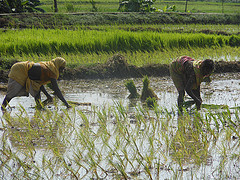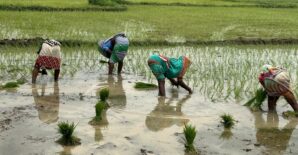
Women Farmers in field, Nalanda District, Bihar. Source: (flickr) Divya Pandey, IFPRI
Eastern India is waiting for Green Revolution to improve food security and reduce poverty. A large fraction of the population in this part of the country is dependent on agriculture for food and livelihood security. The region is home to the highest density of rural poor in the world and poverty is high among agricultural laborers and sub-marginal farmers cultivating less than 0.5 ha land. Despite several government efforts in the past, eastern India still lags when it comes to agricultural development. Though the region has the best of soils in the country and an abundance of water, sunshine and labor, agricultural performance is appears to be of subsistence level only.
The majority of farming families in this region are poor; increasing their net returns from agriculture is essential to reduce poverty. However, the returns from agriculture are significantly lesser in eastern India compared to, say, the north-western states. For example, average net returns from paddy are 5-7 times lower in Bihar than that in Haryana and Punjab. The crop yields are low and almost stagnating in eastern India compared to the north-western and other parts of the country. For example, average yield of rice is around 2-2.5 tons/ha in Bihar (and similar in other states) compared to 5 tons/ha in Haryana and 6 tons/ha in Punjab. In the case of wheat, the yield is around 2.5 tons/ha in Bihar—significantly below the national average and much below the yield levels in Punjab and Haryana (4.5-5 tons/ha).
High population pressure on land, combined with relatively low crop-yields, results in lower average per capita income for farm households in the region. The average annual farm incomes in eastern states are also nearly half of the national average. The region is also highly vulnerable to climate change and thus suffers from high inter-year crop yield variability, making agriculture more vulnerable to climate extremes such as droughts and floods. For example, during 2009, a drought year, paddy yields in Bihar dropped by nearly 15% compared to normal year yields, leading to serious social and economic impacts. A similar situation played out in other eastern states, too; however, in north-western states like Haryana and Punjab, the yields were similar to that in normal years. Therefore, the major policy challenge is to promote sustainable intensification of agriculture to make agriculture more profitable and resilient to climate change.
IFPRI conducted some surveys in major states of India to map the adoption of improved varieties of crops and new technologies. Surveys from the eastern states show that most farmers there continue to use 25-30 years-old seed varieties with low yield potential and high susceptibility to biotic and abiotic stresses. Further there is negligible adoption of conservation agriculture (CA) technologies (zero tillage, laser land leveller, etc). In contrast, Punjab and Haryana are adopting the latest varieties and technologies. Non-availability and lack of knowledge are reported to be the important constraints in adopting modern varieties and technologies. Lack of a legal framework for land leasing was also stated to be a constraint in adopting the latest technologies and committing investment to development of farm assets. Global experiences reveal that legalised land leasing improves efficiency and reduces poverty.
Despite all constraints, in recent years, agriculture in eastern India has begun to transform, but the pace needs to be accelerated by reforming policies, institutions, and markets and by developing agri-infrastructure. Diversification of agriculture in eastern India towards high-value produce is the next step forward to increase farmer’s income. There is enormous scope for dairy, horticulture and fisheries in eastern India. An integrated-farming-system approach can generate additional incomes for farmers along with higher crop and water productivity. Research shows integrated farming system is the most reliable way of obtaining high incomes to the farmers. It would need investment in developing physical and financial infrastructure such as agro-processing, rural warehouses, cold storages, cold chains, and financing institutions.
Market availability is yet another factor to consider. In the absence of suitable marketing facilities in the region, most farmers sell their surplus at non-remunerative prices soon after harvests. In addition, marketing and the ability to negotiate a good price for produce is severely constrained. Therefore, adequate facilities need to be created in rural areas through public–private partnership to provide price advantage, reduce transaction costs and give access to efficient input- and output-markets. The region also has experienced low investment in agriculture development, especially on land, water, markets and extension services in comparison to other parts of India. IFPRI research shows that encouraging private investment in irrigation development will trigger agricultural growth in the region.
The success of all efforts will rely on how farmers are consolidated through self-help groups or farmer-producer organisations or cooperatives to take advantage of economies-of-scale.
Finally, a comprehensive approach by integrating technologies, policies, institutions and agri-infrastructure is necessary to usher in a new green revolution, in eastern India this time.
This piece was originally published in Financial Express.


